In a world that’s becoming increasingly interconnected, the ability to speak multiple languages opens doors to new opportunities and enriches our understanding of different cultures. One language that stands out in this global landscape is Spanish.
But, what are the best apps for learning Spanish?
Follow me as I guide you through the best apps for learning Spanish. Whether you’re a travel enthusiast, a business professional, or simply eager to broaden your horizons, learning Spanish can be a rewarding endeavor.
Let’s go.
Why Should Your Learn the Spanish Language?
Spanish, spoken by over 460 million people worldwide, is not just a language—it’s a key to diverse cultures, vibrant traditions, and exciting adventures.
From navigating the streets of Barcelona to striking up conversations in Latin America, learning Spanish can enhance your travel experiences, boost your career prospects, and foster a deeper appreciation for art, literature, and music.
Quick Overview of the Best Apps for Learning Spanish
| App | Best For | Free Trial | Base Price |
| Pimsleur | Audio-based learning | Yes | $15 / month |
| Spanishdict | Comprehensive learning | Yes | Free with Premium ($12.99 / mo) |
| Babbel | Structured lessons | Yes | $4.95 – $9.95 / month |
| Busuu | Social language learning | Yes | $11.99 / month |
| Duolingo | Gamified language learning | Yes | Free with Duolingo Plus $6.99 / mo) |
| Rosetta Stone | Immersive language learning | Yes | $15.99 / month |
| FluentU | Authentic content immersion | Yes | $30 / month |
My Top 7 Best Apps for Learning Spanish
Let’s go a bit deeper and find out what the best apps for learning Spanish are.
1. Best Spanish App for Conversational Application: Pimsleur
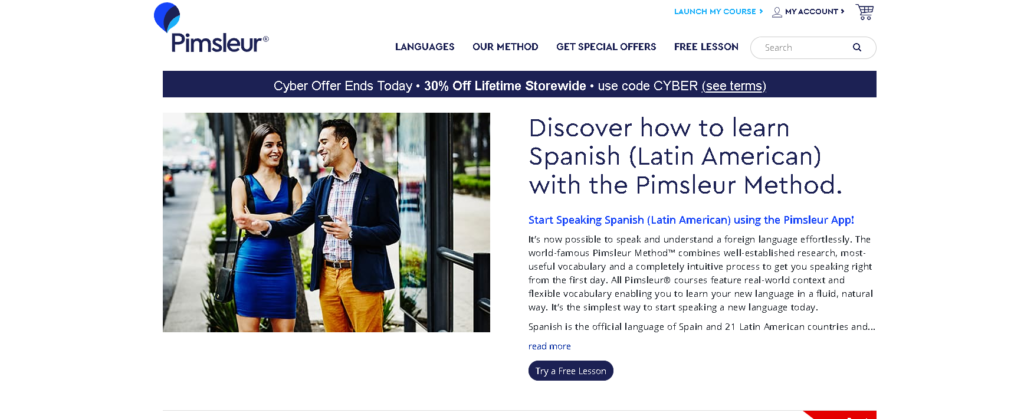
Pimsleur takes a unique approach with its audio-focused lessons, making it an excellent choice for honing pronunciation and listening skills. Its scientifically proven method ensures that learners can speak confidently in real-life situations.
Best for:
Pimsleur is ideal for individuals seeking to master conversational Spanish through its effective audio-focused approach.
Base Price:
To get full access to Pimsleur’s learning lessons, you’ll normally pay a monthly fee of only $15.
What I Like About Pimsleur:
- Effective audio learning for improved pronunciation and listening skills.
- Structured progression with sequential lessons reinforcing vocabulary and grammar naturally.
- Scientifically proven method backed by research for efficient language acquisition.
- Portability allows for on-the-go learning with convenient audio lessons.
- Confidence boost through repetitive lessons, fostering comfort in real-life conversations.
- Affordable subscription options cater to different budgets.
Pros:
- Enhances listening and pronunciation skills.
- Sequential lessons reinforce vocabulary and grammar.
- Backed by research for efficient language acquisition.
- Learn on-the-go with convenient audio lessons.
- Repetitive lessons boost confidence in real-life conversations.
- Various subscription plans for different budgets.
Cons:
- Less interactive compared to some other apps.
- Content may be somewhat limited for advanced learners.
2. Best Spanish App for General Translation: Spanishdict
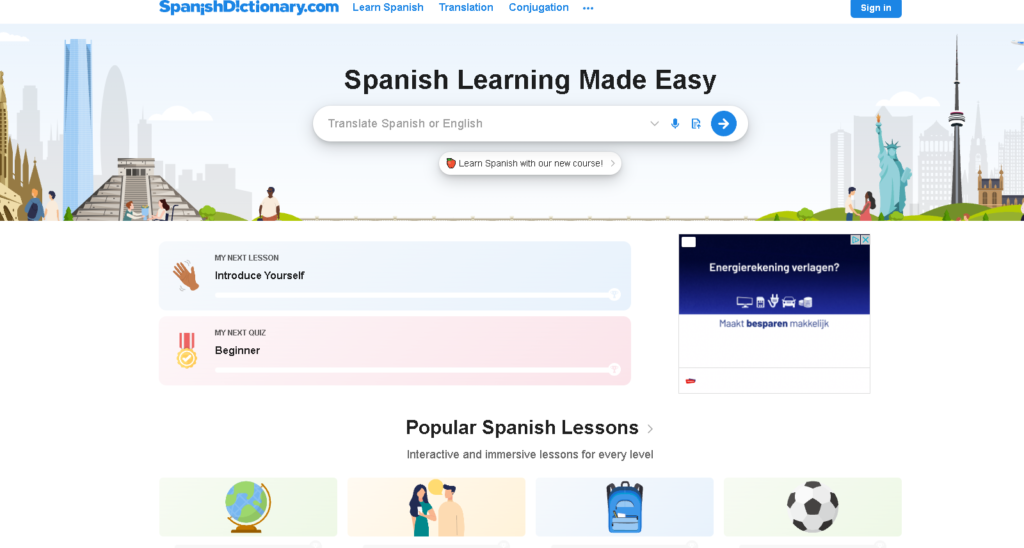
Spanishdict goes beyond a traditional learning app, offering a comprehensive dictionary, grammar resources, and interactive features. It’s a go-to resource for those seeking a well-rounded language learning experience.
Best For:
Spanishdict is ideal for individuals seeking a comprehensive approach to mastering conversational Spanish, combining effective audio learning with rich resources for grammar, vocabulary, and interactive engagement.
Base Price:
Spanishdict offers a free version with essential features and a premium subscription for more advanced learning tools and an ad-free experience. The premium subscription provides additional features at a competitive price of $12.99 / month or a yearly rate of only $59.99, catering to various budget preferences.
What I like about Spanishdict:
Spanishdict stands out for its comprehensive and interactive Spanish learning approach, blending audio lessons with resources like a dictionary and grammar guides. The user-friendly interface, emphasis on pronunciation practice, and progress tracking make it a dynamic and enjoyable learning experience. With an affordable premium subscription, it’s an excellent choice for those committed to mastering Spanish comprehensively.
Pros:
- Rich Resources
- Interactive Engagement
- User-Friendly Interface
- Pronunciation Tools
- Progress Tracking
- Affordable Premium
Cons:
- Limited Visuals
- Content Complexity for Advanced Learners
3. Best Spanish App for Real World Conversations: Babbel
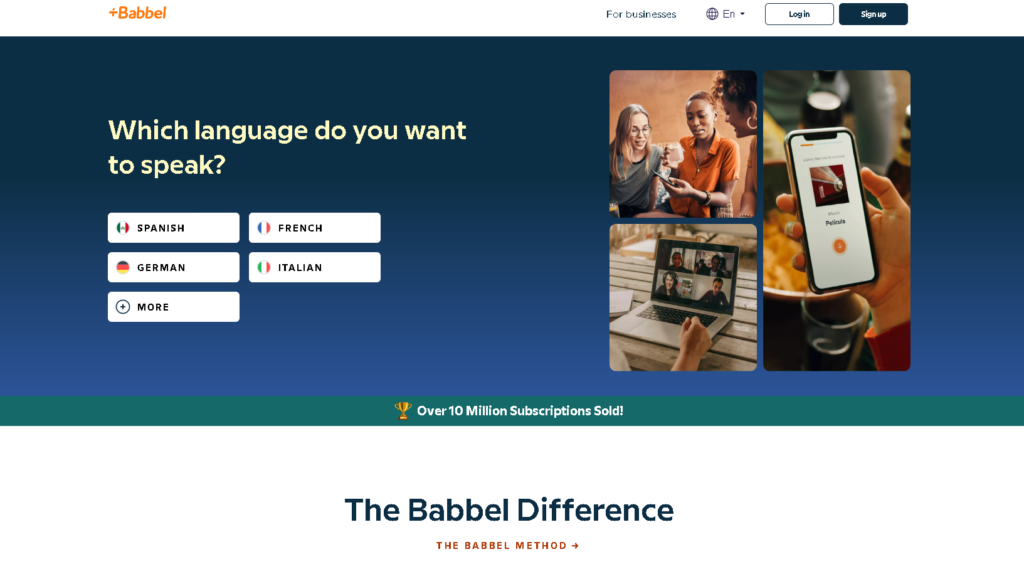
Babbel stands out with its structured lessons, emphasizing practical conversations. Whether you’re a beginner or looking to enhance your existing skills, Babbel’s user-friendly interface and effective teaching methods make it a top choice.
Best For:
Babbel is perfect for individuals seeking structured lessons that emphasize practical conversations, making it an excellent choice for those who prioritize real-world language skills.
Base Price:
Babbel offers a subscription-based model, with various plans available. Subscription costs can vary from $4.95 – $9.95 / month, which is very low compared to other platforms. While it is not a free app, the pricing is reasonable considering the structured lessons and additional features it provides.
What I Like About Babbel:
Babbel stands out for its structured and practical approach to language learning. With well-organized lessons emphasizing phrases for real-life use, a user-friendly interface, speech recognition for pronunciation improvement, and diverse exercises, it offers a comprehensive learning experience. Additionally, Babbel goes beyond basics, providing cultural insights for a deeper understanding of Spanish-speaking cultures.
Pros:
- Structured Lessons
- Practical Conversations
- User-Friendly Interface
- Speech Recognition
- Varied Exercises
- Cultural Insights
Cons:
- Limited Free Content
- May Lack Advanced Material
- Less Gamification Compared to Some Apps
4. Best Spanish App for Speaking Practice: Busuu

Busuu combines language learning with social interaction, allowing users to practice with native speakers. Its innovative approach fosters a sense of community, making the learning process both effective and enjoyable.
Best For:
Busuu is ideal for learners seeking a social language learning experience, combining lessons with opportunities to practice with native speakers for authentic and real-life conversations.
Base Price:
Busuu offers a free version with essential features and a premium subscription for more advanced tools, including personalized study plans and official language certificates. The premium subscription is competitively priced at a price of $11.99 / month, providing added value for those dedicated to advancing their language skills.
What I Like About Busuu:
Busuu impressed me with its focus on authentic social interaction, allowing learners to engage in real conversations with native speakers. Personalized study plans, speech recognition for pronunciation improvement, varied exercises, cultural insights, and the option for official certificates make it a comprehensive and rewarding language learning experience.
Pros:
- Authentic conversations with native speakers.
- Tailored study plans for individual goals.
- Technology for improved pronunciation.
- Diverse activities for a comprehensive learning experience.
- Enhanced understanding through cultural context.
- Recognition of language proficiency.
Cons:
- Social learning may depend on partner availability.
- Depth may be limited for advanced learners.
5. Best Spanish App for Staying Motivated: Duolingo
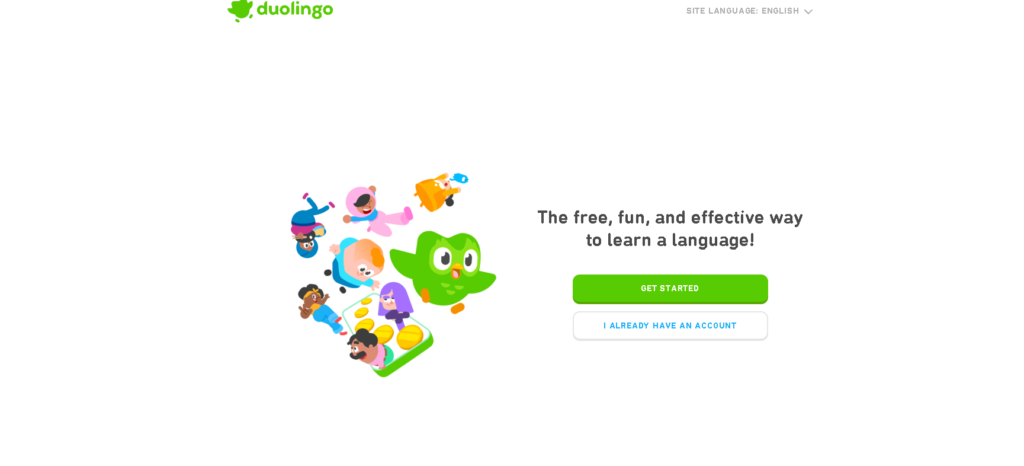
Duolingo takes a gamified approach to language learning, turning education into an engaging experience. With its fun and interactive lessons, Duolingo is particularly popular among beginners looking to build a solid foundation in Spanish.
Best For:
Duolingo is perfect for individuals who prefer a gamified approach to language learning, making it an engaging and enjoyable choice for beginners looking to build a solid foundation in Spanish.
Base Price:
Duolingo offers a free version with ads and a premium subscription, Duolingo Plus, which provides an ad-free experience, offline access, and progress tracking. The premium subscription is competitively priced at a price of $6.99 / month, offering additional features for dedicated learners.
What I Like About Duolingo:
Duolingo stands out with its gamified and engaging approach to language learning, offering structured lessons that gradually increase in complexity. The adaptive learning algorithm personalizes the experience, catering to individual strengths and weaknesses. Diverse exercises appeal to various learning styles, and community features encourage connection and practice. With its mobile-friendly design, Duolingo makes language learning convenient and enjoyable for beginners.
Pros:
- Engaging and fun approach to language acquisition.
- Gradual complexity for a systematic learning journey.
- Personalized experience catering to individual strengths and weaknesses.
- Diverse activities for different learning styles.
- Social features for connecting and practicing with others.
- Mobile-friendly design for convenient, on-the-go learning.
Cons:
- The gamified approach may not suit those who prefer a more traditional learning style.
- Duolingo’s focus on language skills might limit exposure to cultural nuances.
6. Best Spanish App for Natural Language Acquisition: Rosetta Stone
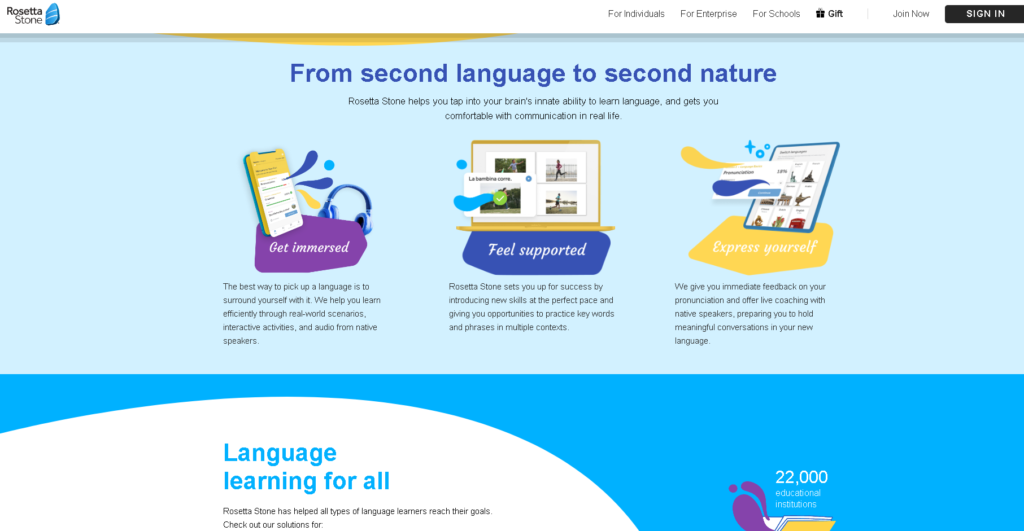
Rosetta Stone is synonymous with language fluency. Its immersive method mimics the way we naturally learn languages, making it an ideal choice for those committed to achieving a high level of proficiency.
Best For:
Rosetta Stone is best suited for learners committed to achieving fluency through an immersive language learning experience, making it an excellent choice for those seeking a comprehensive and high-level proficiency in Spanish.
Base Price:
Rosetta Stone offers a subscription-based model, providing various plans with access to all languages, including Spanish. Pricing for Rosetta Stone is $15.99 / month. While it may be on the higher end of the price spectrum, the investment is justified by its reputation for language fluency.
What I Like About Rosetta Stone:
Rosetta Stone excels in immersive language learning, emphasizing natural acquisition through association and context. Its speech recognition ensures precise pronunciation, while the premium plan offers live tutoring for personalized guidance. Comprehensive content covers vocabulary, grammar, and cultural nuances, providing a great approach to fluency. Adaptive learning tailors to individual progress and offline lessons add flexibility to the experience.
Pros:
- Natural language acquisition through association and context.
- Technology for accurate pronunciation skills.
- Personalized guidance with live tutoring sessions.
- In-depth coverage of vocabulary, grammar, and cultural nuances.
- Progress adapts to individual learning pace.
- Flexibility with lessons available for offline use.
Cons:
- The subscription cost may be on the higher end compared to some other language learning apps.
- Rosetta Stone’s immersive method may be intense for those seeking a more casual language learning experience.
7. Best Spanish App for Learning with Authentic Media: FluentU

FluentU sets itself apart by using real-world videos to teach Spanish. By immersing learners in authentic content, FluentU provides a dynamic and practical learning experience.
Best For:
FluentU is an ideal choice for learners who appreciate language immersion through authentic content, making it perfect for those who want to develop real-life conversational skills in Spanish.
Base Price:
FluentU operates on a subscription-based model, offering various plans. You’ll get access to FluentU for either $29.99 / month or $8 / month (billed annually). While it may not be a free app, the investment provides access to a vast library of authentic Spanish content, ensuring an enriching and immersive learning experience.
What I Like About FluentU:
FluentU stands out for its immersive language learning using authentic content like movie trailers and news. Interactive features, personalized quizzes, and adaptive content cater to individual preferences and proficiency levels. Progress tracking ensures measurable advancement, and the platform’s contextual insights enrich the understanding of Spanish culture.
Pros:
- Exposure to genuine language use through real-world videos.
- Engaging features like instant definitions and pronunciation help reinforce learning.
- Customized quizzes and exercises based on individual preferences.
- Content caters to learners at different proficiency levels.
- Users can measure advancement and revisit previous videos.
- Cultural and contextual insights enrich language understanding.
Cons:
- Not a free app; however, the subscription cost is justified by the rich, authentic content.
How to Choose Your Best Apps for Learning Spanish?
Learning Spanish through apps offers a convenient and flexible way to acquire a new language, but with an abundance of options available, selecting the right app is crucial for a successful language-learning journey.
To choose the best Spanish learning app, start by defining your goals and considering your preferred learning style—whether it’s interactive or more traditional.
Evaluate app features, read user reviews, and explore free trials for hands-on experience. Check the app’s reputation, ensure it supports Spanish language nuances, and assess its accessibility.
This thoughtful approach will help you find the app that aligns with your learning preferences and goals for an effective Spanish language learning experience.
Learning Spanish through Online Courses
When it comes to learning Spanish, the choice between online courses and language apps depends on your preferences and learning style. Online courses, often available on platforms like Coursera, Udemy, or official language institutes, offer comprehensive lessons, structured modules, and often come with interactive assignments. These courses are beneficial for those seeking a more in-depth understanding of Spanish, with a focus on grammar rules, cultural insights, and practical communication skills.
On the other hand, Spanish learning apps like Duolingo, Babbel, or Rosetta Stone provide a more flexible and casual approach. They often use gamified elements, short lessons, and repetition to reinforce vocabulary and basic conversational skills. Apps are suitable for learners who prefer a more relaxed, on-the-go experience and want to incorporate language learning seamlessly into their daily lives.
Best Spanish Learning Courses
Here is a small list of some good Spanish learning courses, also find in my Best Skillshare classes and Best Udemy courses articles:
- Spanish for Beginners. The complete Method. Level 1. (Skillshare)
- Complete Spanish Course: Master Spanish Beginner to Advanced (Udemy)
- Spanish for Beginners: Spanish Crash Course (Conversational) (Skillshare)
Also Check Out my Udemy vs Skillshare article to see who wins!
Wrap Up
Learning Spanish is like opening a door to a whole new world. It’s not just about words; it’s about discovering different cultures, making new friends, and growing as a person. Whether you’re doing it for work, travel, or just because you love it, every step you take in learning Spanish is a step toward exciting possibilities.
So, enjoy the journey, celebrate your progress, and let the adventure of learning Spanish bring you lots of happiness and new experiences. Good luck! 🌎🌟
Frequently Asked Questions (FAQ)
1. Which Spanish Learning App is best for beginners?
Duolingo and Babbel are excellent choices for beginners, offering gamified learning and structured lessons, respectively.
2. Are there free trials available for these apps?
Yes, many of these best apps for learning Spanish offer free trials, allowing you to explore their features before committing to a subscription.
3. Can learning Spanish boost my career?
Yes, proficiency in Spanish enhances employability, especially in industries seeking bilingual professionals, offering diverse job opportunities. So choose your best apps for learning Spanish and start learning!
4. How does learning Spanish benefit personal growth?
Learning a new language, like Spanish, stimulates cognitive skills, enhances problem-solving abilities, and fosters resilience, contributing to personal growth.
5. Is there a connection between learning Spanish and traveling?
Absolutely. Learning Spanish enhances travel experiences by facilitating communication with locals, fostering connections, and providing a deeper understanding of different cultures.
6. Are there benefits beyond language proficiency?
Yes, learning Spanish can broaden perspectives, connect you with a global community, and serve as a foundation for understanding other Romance languages.
7. Can I learn Spanish on my own using language apps?
Yes, many of these best apps for learning Spanish offer self-paced learning with interactive features, making it possible to learn Spanish independently.
8. How long does it take to become fluent in Spanish?
The time to fluency varies for each individual. Consistent practice, immersion, and dedication play significant roles in the learning process.
9. Is Spanish hard to learn?
The difficulty of learning Spanish varies from person to person. While it has similarities to English and other Romance languages, regular practice and commitment are essential for effective learning.

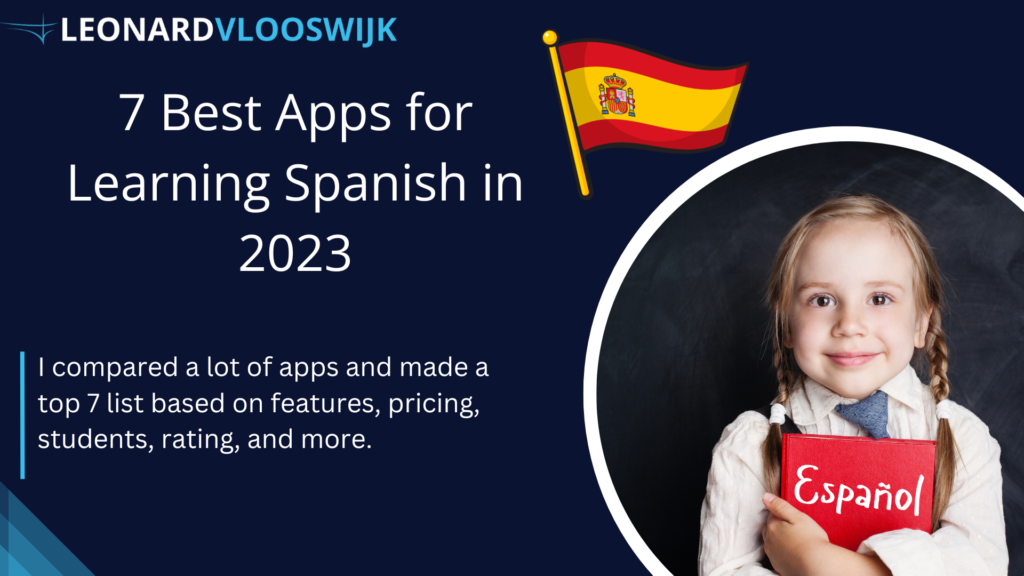
Pingback: 7 Best Spanish Learning Podcasts in 2023 (For All Levels) - Leonard Vlooswijk
Pingback: 7 Best Apps to Learn Italian For Every Level in 2023 (Free & Paid) - Leonard Vlooswijk
Pingback: 7 Best Apps to Learn Japanese in 2024 (Honest Review) - Leonard Vlooswijk
Pingback: Is Vietnamese Hard to Learn in 2024? The Most Honest Review You'll Ever Read! - Leonard Vlooswijk
Pingback: Is Spanish hard to learn in 2024? The Most Honest Guide You'll Ever Read! - Leonard Vlooswijk
Pingback: Is Hindi Hard to Learn in 2024? The Most Honest Review You'll Ever Read! - Leonard Vlooswijk
Pingback: Babbel Review: Is It Truly Worth It in 2024? - Leonard Vlooswijk
Pingback: Pimsleur Review: Is It Truly Worth It In 2024? - Leonard Vlooswijk